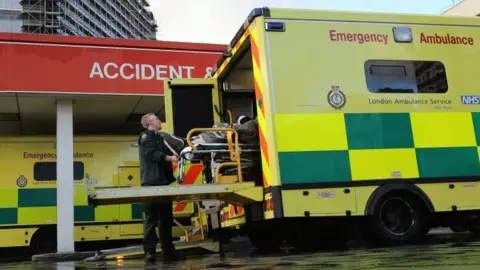England sees 'worst summer on record' for A&E waits
 Getty Images
Getty ImagesThis summer was the worst for A&E waiting times in England since the four-hour target was introduced.
Analysis by BBC Newsnight and the Nuffield Trust found an average of 86% of patients were admitted, transferred or discharged from A&E within four hours in the six months to September.
This is the worst performance in that period since the 95% target was brought in in 2004.
NHS England said it had been "the busiest ever summer" for A&Es.
"In the past six months, there have been half a million more visits to A&E than at the same point last year," a spokesman said.
Doctors warned that the system was "running out of resilience" and that winter in A&Es was going to be "really difficult".
In September, there were 41,000 more people treated in A&Es within four hours, compared with September 2018.
But there were 64,921 patients waiting more than four hours from decision to their actual admission to further care.
Of these patients, 455 waited more than 12 hours. This is a 195.5% increase from the previous year.
These are known as trolley waits, because patients are left on trolleys in temporary waiting areas while a bed is found.
"Lying on a trolley is not good for you in any way," said Dr Katherine Henderson, President of the Royal College of Emergency Medicine.
"We know these patients can suffer harm because they're in the department for so long."
Over the April-September period, there were 2,591 trolley waits - more than double the number last year.
The numbers of trolley waits are small compared with the numbers of patients who go through A&E (there were 2.14 million attendees in September this year).

The last time the government's four-hour target was met was in July 2015.
Since then, A&E waiting times have typically increased in winters - the "winter crisis" - and recovered in summers, with around 90% of patients being seen within four hours in the summer months (April - September).
But this summer that figure was 85%.
"This is the worst summer on record," said Helen Buckingham of the Nuffield Trust. "And the thing that we have to remember is that behind those numbers there are people."
"Looking forward to winter," she added, "the NHS has historically used the summer to catch its breath. It's been much harder to do that this year. It's not going to be easy."
Dr Henderson agreed. "I think the system is running out of resilience," she said. "It looks like we are really struggling with our workforce at times and we're not recovering as quickly as we used to.
"We're seeing sicker, more complex older patients coming to the emergency department... Very often those patients are the successes of the NHS."
If you can't see the NHS Tracker, click or tap here.

The four-hour target was introduced in NHS England in 2004-2005 in an attempt to reduce waiting times.
The target itself is currently under review, after NHS England said it seemed to be distorting priorities.
NHS England wants to see patients who come in with heart attacks, acute asthma, sepsis and stroke starting their care within an hour.
The changes will be piloted this year and, if successful, could be introduced in 2020.
A Department of Health and Social Care spokeswoman said: "Winter is always challenging and we're backing the NHS with £1.8bn for world-class facilities to improve front-line patient care across the country - on top of our historic commitment of £33.9bn more of taxpayers' money a year by 2023-24."
